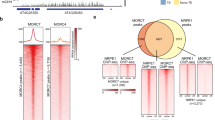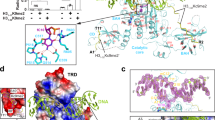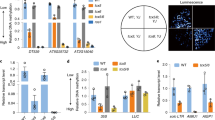Abstract
Gene silencing in eukaryotes is associated with the formation of heterochromatin, a complex of proteins and DNA that block transcription. Heterochromatin is characterized by the methylation of cytosine nucleotides of the DNA, the methylation of histone H3 at lysine 9 (H3 Lys 9), and the specific binding of heterochromatin protein 1 (HP1) to methylated H3 Lys 9 (refs 1–7). Although the relationship between these chromatin modifications is generally unknown, in the fungus Neurospora crassa, DNA methylation acts genetically downstream of H3 Lys 9 methylation8. Here we report the isolation of KRYPTONITE, a methyltransferase gene specific to H3 Lys 9, identified in a mutant screen for suppressors of gene silencing at the Arabidopsis thaliana SUPERMAN (SUP) locus. Loss-of-function kryptonite alleles resemble mutants in the DNA methyltransferase gene CHROMOMETHYLASE3 (CMT3)9, showing loss of cytosine methylation at sites of CpNpG trinucleotides (where N is A, C, G or T) and reactivation of endogenous retrotransposon sequences. We show that CMT3 interacts with an Arabidopsis homologue of HP1, which in turn interacts with methylated histones. These data suggest that CpNpG DNA methylation is controlled by histone H3 Lys 9 methylation, through interaction of CMT3 with methylated chromatin.
This is a preview of subscription content, access via your institution
Access options
Subscribe to this journal
Receive 51 print issues and online access
$199.00 per year
only $3.90 per issue
Buy this article
- Purchase on Springer Link
- Instant access to full article PDF
Prices may be subject to local taxes which are calculated during checkout




Similar content being viewed by others
References
Rea, S. et al. Regulation of chromatin structure by site-specific histone H3 methyltransferases. Nature 406, 593–599 (2000)
Nakayama, J., Rice, J. C., Strahl, B. D., Allis, C. D. & Grewal, S. I. Role of histone H3 lysine 9 methylation in epigenetic control of heterochromatin assembly. Science 292, 110–113 (2001)
Strahl, B. D. & Allis, C. D. The language of covalent histone modifications. Nature 403, 41–45 (2000)
Jenuwein, T. & Allis, C. D. Translating the histone code. Science 293, 1074–1080 (2001)
Lachner, M., O'Carroll, D., Rea, S., Mechtler, K. & Jenuwein, T. Methylation of histone H3 lysine 9 creates a binding site for HP1 proteins. Nature 410, 116–120 (2001)
Bannister, A. J. et al. Selective recognition of methylated lysine 9 on histone H3 by the HP1 chromo domain. Nature 410, 120–124 (2001)
Jacobs, S. A. et al. Specificity of the HP1 chromo domain for the methylated N-terminus of histone H3. EMBO J. 20, 5232–5241 (2001)
Tamaru, H. & Selker, E. U. A histone H3 methyltransferase controls DNA methylation in Neurospora crassa. Nature 414, 277–283 (2001)
Lindroth, A. M. et al. Requirement of CHROMOMETHYLASE3 for maintenance of CpXpG methylation. Science 292, 2077–2080 (2001)
Tschiersch, B. et al. The protein encoded by the Drosophila position-effect variegation suppressor gene Su(var)3-9 combines domains of antagonistic regulators of homeotic gene complexes. EMBO J. 13, 3822–3831 (1994)
Allshire, R. C., Nimmo, E. R., Ekwall, K., Javerzat, J. P. & Cranston, G. Mutations derepressing silent centromeric domains in fission yeast disrupt chromosome segregation. Genes Dev. 9, 218–233 (1995)
Ivanova, A. V., Bonaduce, M. J., Ivanov, S. V. & Klar, A. J. The chromo and SET domains of the Clr4 protein are essential for silencing in fission yeast. Nature Genet. 19, 192–195 (1998)
Peters, A. H. et al. Loss of the suv39h histone methyltransferases impairs mammalian heterochromatin and genome stability. Cell 107, 323–337 (2001)
Jacobsen, S. E. & Meyerowitz, E. M. Hypermethylated SUPERMAN epigenetic alleles in Arabidopsis. Science 277, 1100–1103 (1997)
Bartee, L., Malagnac, F. & Bender, J. Arabidopsis cmt3 chromomethylase mutations block non-CG methylation and silencing of an endogenous gene. Genes Dev. 15, 1753–1758 (2001)
Baumbusch, L. O. et al. The Arabidopsis thaliana genome contains at least 29 active genes encoding SET domain proteins that can be assigned to four evolutionarily conserved classes. Nucleic Acids Res. 29, 4319–4333 (2001)
Tachibana, M., Sugimoto, K., Fukushima, T. & Shinkai, Y. Set domain-containing protein, G9a, is a novel lysine-preferring mammalian histone methyltransferase with hyperactivity and specific selectivity to lysines 9 and 27 of histone H3. J. Biol. Chem. 276, 25309–25317 (2001)
Finnegan, E. J., Peacock, W. J. & Dennis, E. S. Reduced DNA methylation in Arabidopsis thaliana results in abnormal plant development. Proc. Natl Acad. Sci. USA 93, 8449–8454 (1996)
Ronemus, M. J., Galbiati, M., Ticknor, C., Chen, J. & Dellaporta, S. L. Demethylation-induced developmental pleiotropy in Arabidopsis. Science 273, 654–657 (1996)
Kishimoto, N. et al. Site specificity of the Arabidopsis METI DNA methyltransferase demonstrated through hypermethylation of the superman locus. Plant Mol. Biol. 46, 171–183 (2001)
Soppe, W. J. et al. The late flowering phenotype of fwa mutants is caused by gain-of-function epigenetic alleles of a homeodomain gene. Mol. Cell 6, 791–802 (2000)
Vongs, A., Kakutani, T., Martienssen, R. A. & Richards, E. J. Arabidopsis thaliana DNA methylation mutants. Science 260, 1926–1928 (1993)
Steimer, A. Endogenous targets of transcriptional gene silencing in Arabidopsis. Plant Cell 12, 1165–1178 (2000)
Henikoff, S. & Comai, L. A DNA methyltransferase homolog with a chromodomain exists in multiple polymorphic forms in Arabidopsis. Genetics 149, 307–318 (1998)
Akhtar, A., Zink, D. & Becker, P. B. Chromodomains are protein–RNA interaction modules. Nature 407, 405–409 (2000)
Gaudin, V. et al. Mutations in LIKE HETEROCHROMATIN PROTEIN 1 affect flowering time and plant architecture in Arabidopsis. Development 128, 4847–4858 (2001)
Peters, A. H. F. M. et al. Histone H3 lysine 9 methylation is an epigenetic imprint of facultative heterochromatin. Nature Genet. 30, 77–80 (2002)
Acknowledgements
We thank T. Jenuwein for the GST–Suv constructs and H3 N-terminal peptides, Y. Shinkai for the H3 N-terminal GST fusion constructs, A. Kouzarides for an HP1 construct, and S. Peyvandi for technical assistance. This work was supported by grants from the National Institutes of Health, the Beckman Young Investigator programme, and the Searle Scholars Foundation to S.E.J. J.P.J. was supported by an NIH training grant and A.M.L. by a post-doctoral fellowship from the Damon Runyon Walter Winchel Foundation.
Author information
Authors and Affiliations
Corresponding author
Ethics declarations
Competing interests
The authors declare that they have no competing financial interests
Supplementary information
41586_2002_BFnature731_MOESM1_ESM.pdf
Molecular nature of the kryptonite alleles, PCR primers and molecular markers used in this study and supplementary table 1 (PDF 9 kb)
Rights and permissions
About this article
Cite this article
Jackson, J., Lindroth, A., Cao, X. et al. Control of CpNpG DNA methylation by the KRYPTONITE histone H3 methyltransferase. Nature 416, 556–560 (2002). https://doi.org/10.1038/nature731
Received:
Accepted:
Published:
Issue Date:
DOI: https://doi.org/10.1038/nature731
This article is cited by
-
DNA Methylation Analysis Reveals Potential Mechanism in Takifugu rubripes Against Cryptocaryon irritans Infection
Marine Biotechnology (2024)
-
DNA methylation and lipid metabolism are involved in GA-induced maize aleurone layers PCD as revealed by transcriptome analysis
BMC Plant Biology (2023)
-
Arabidopsis histone H3 lysine 9 methyltransferases KYP/SUVH5/6 are involved in leaf development by interacting with AS1-AS2 to repress KNAT1 and KNAT2
Communications Biology (2023)
-
Identification and validation of seed dormancy loci and candidate genes and construction of regulatory networks by WGCNA in maize introgression lines
Theoretical and Applied Genetics (2023)
-
The RNA-binding domain of DCL3 is required for long-distance RNAi signaling
aBIOTECH (2023)
Comments
By submitting a comment you agree to abide by our Terms and Community Guidelines. If you find something abusive or that does not comply with our terms or guidelines please flag it as inappropriate.



